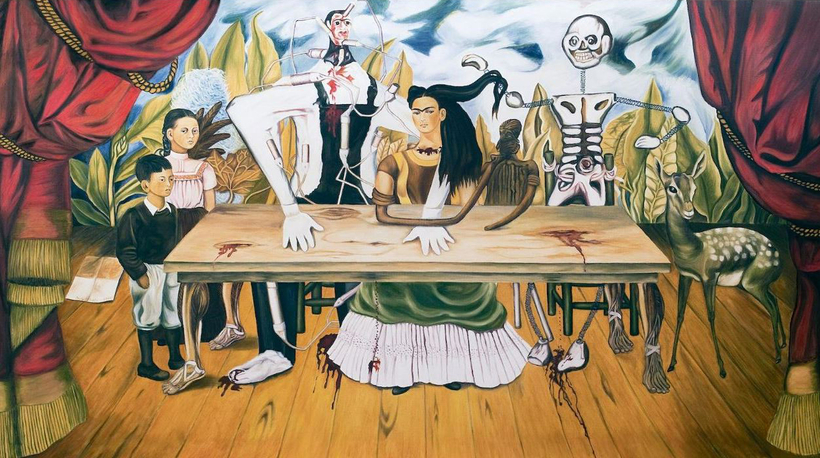During her divorce from the artist Diego Rivera, Frida Kahlo began work on a masterpiece that gave voice to her anger at the infidelities of a man who described himself as a “depraved victim” of his “own appetites”.
At the peak of her career after her first solo exhibitions in New York and Paris, Kahlo’s work, The Wounded Table, was unveiled in 1940 in Mexico City.
An unusually large work with echoes of Leonardo’s The Last Supper, it toured the world before Kahlo, a socialist, decided to donate it to the Soviet Union in 1943 in an attempt to please the Communist Party. Kahlo had once had an affair with Leon Trotsky.
Yet the work, which depicted Kahlo seated at a table that has human legs, surrounded by two children, a papier-mâché skeleton, a pre-Colombian figurine and her pet deer Granizo, was never displayed in Russia.

Kahlo’s surrealist style was “alien to the principles of Soviet realist art” and therefore “the possibility of displaying such artworks in the Soviet Union is excluded”, a letter written in 1948 in Moscow said.
It was eventually rescued from the Pushkin State Museum of Fine Arts by Rivera and taken to Warsaw for an exhibition in 1955, a year after Kahlo’s death at the age of 47. It then vanished.
Today, the hunt for the work continues and in art circles has become a mythical fixation. The art historians Helga Prignitz-Poda and Katarina Lopatkina have spent years trying to find it.
In a joint paper, they said that the Kremlin would not have wanted Kahlo’s work back after it was exhibited in Warsaw and that it was likely to still be in Poland.
Kahlo had once had an affair with Leon Trotsky.
Of the 300 or so works produced by Kahlo during her life, more than half are either missing, confirmed to have been destroyed or in the hands of private owners who refuse to loan them to exhibitions, they said.
“It’s crazy how many people write to us, even over Instagram, to verify the painting,” Lopatkina told The Times. “But they are all fakes.”
The world’s love affair with Kahlo has grown since her death and emergence as a feminist pioneer. Her high profile has renewed interest in the whereabouts of her missing paintings and led to a number of fake Wounded Tables “reappearing” on the market. Today, the demand for Kahlo has its own nickname: “Fridamania.”
Four years ago, the world waited with bated breath as it seemed that the hunt had finally come to an end.
Cristian López, a Spanish art dealer who said he represented the anonymous owner of the painting, claimed that it was in a London warehouse awaiting a buyer willing to part with €40 million (about $43 million). “Time will give us the truth,” said López. He claimed that specialists had authenticated the painting but declined to identify them. “Whoever proves genuine interest and the ability to pay €40 million can spend as much time as wanted with their experts analyzing the work.”
Lopatkina doubts that it was the real thing. “None of the paintings are real,” she said. “The Wounded Table was painted on a big piece of heavy wood. These paintings that keep appearing are on canvas.”
Hans-Jérgen Gehrke, an art collector who operated a museum dedicated to Kahlo’s works in southwestern Germany, considered it “implausible if not directly ridiculous” that López, a 22-year-old businessman operating a website from a town in northwestern Spain, was the guardian of the missing painting. “There are thousands of Frida Kahlo fakes,” Gehrke said. “She is possibly the artist who has painted more dead than in life.”

Lopatkina said the painting had been influenced by her marriage to Rivera and her burning ambition. “You needed to paint large paintings to be able to get your own exhibition, so after her marriage broke down she started painting these,” she said.
“I quite like this story because after this exhibition they got back together [and] their second marriage was much, much happier.
“What we know is that it was taken to an exhibition in Poland in 1955, then there are some traces of it in Romania, but I think they just didn’t know what to do with it and it was destroyed.
“It was too ornate, too bourgeois for the USSR. Too subversive. Art was supposed to be realistic. Whoever opened the crate probably had no idea what to do with it.”
Lopatkina, who has worked at the Hermitage Museum in St Petersburg, believes that The Wounded Table probably suffered the same fate at the hands of the Soviet regime as other pieces of art.
“I’m sad for all the paintings. We know that there were entire vaults of paintings that were covered in mold and subsequently destroyed. I know there are people out there who still have hope they can find The Wounded Table but I think it is simply lost forever.”
Paulina Olszanka is an Australian journalist covering Poland for The Times of London

